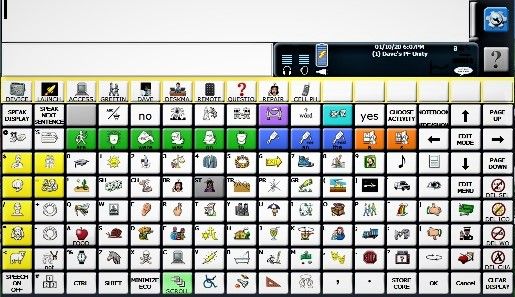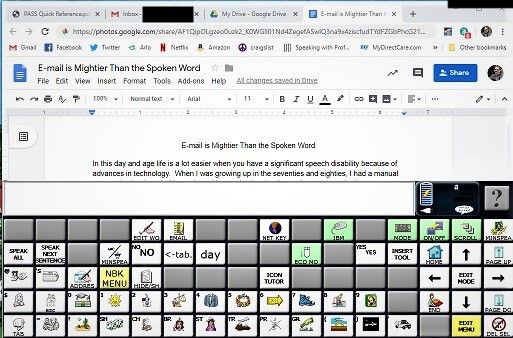Because of advances in technology in this day and age, life is a lot easier for people who have a significant speech disability. When I was growing up in the ’70s and ’80s, I had a manual communication board with words and letters that I pointed to and my communication partner would read whatever I was pointing. As you can imagine, this process was long and cumbersome. For written communication, I had to use an electric typewriter and because I could not use my hands, I used a headstick to type one letter at a time.
I was born with cerebral palsy, a neurological condition that affects my ability to use my hands, walk, and speak. Throughout my life, I had to figure out ways I could get my point across without using my verbal voice. As technology advanced, communication for me became a lot easier. After you read this blog you will see how email has emerged as a powerful communication tool for people with severe speech disabilities.
Fast-forward to 2020
Today I have an electronic communication device called an Accent 1400 which doubles as a Windows tablet. I access my device with a little silver dot on my glasses that reflects light into a camera which moves the pointer on my screen. I have to hold the pointer still for a second to make a selection. The Accent has a language system named Minspeak which is a way of representing language through icons. Communicating using this system is fast because I can form words or phrases with one or two icon combinations instead of typing one letter at a time.

As everything in life, not everything is perfect and there are some issues with my communication technology. When I am talking with somebody in person, they can see me using my communication device to formulate my response. However, sometimes I have problems with conversations over the phone because my communication partner might not understand that I am using a communication device. I do have prestored messages such as “Hello, I am using a communication device, please wait for my full sentence”. But a lot of the time they hang up on me because they think I am a robot. Also, my communication rate is slower than other people and there are times my communication partner does not have the patience to deal with me. Often times they ask to speak to a real person. This is offensive to me.
Enter the power of email
I have discovered that email is a powerful tool for a person who has speech disabilities because I do not need to worry about communication pace, and I can make sure all details are conveyed. While most of conversational breakdowns happen over the phone, there are situations where face-to-face interactions do not go smoothly, such as at the doctor’s office or even with a friend. I think most everyone knows that doctors have a very tight schedule and they do not have a lot of time to interact with patients. Having a communication device complicates things even more. email enables me to gather and relay my thoughts and feelings at my own pace without feeling rushed or ignored.
In certain situations, email can be frustrating because I do not get the immediate feedback as I do with in-person contact. There are times I wonder whether an email was received because I don’t get a response right away. So, I might send another email, putting me at risk of being considered a pain in the butt. Just as it is difficult to know whether a message was received, expressing emotion through email is challenging. The reader may misinterpret my intended feelings, especially when I am using sarcasm. People have said I have a wicked sense of humor and have an expressive face so it is easy to know my nonverbal feedback and know that I am joking. Obviously the reader cannot see the smile on my face or hear me laughing to myself while I am typing.
Typing information with my augmentative and alternative communications device
Most of the time, I use my communication overlay on my Accent to compose documents or email. I usually have the overlay on the full screen and have the open document in the background. Even though this is very convenient, it can also be hard to deal with because I have to remember to put the cursor in the right place. On numerous occasions, I have typed an entire e-mail in the subject line or nowhere at all. The latter is quite frustrating because I have to start all over whereas if I typed inside the subject field, I can just copy and paste into the body of the email. There is a way to have the overlay and document visible at the same time, but this can be awkward because only half of the overlay is accessible at a time and I have to scroll up and down.

There are other ways I can write an e-mail or document which solves the problem of not seeing the location of the cursor. However, they aren’t not as convenient as just using my communication overlay. The Accent can be attached to a laptop via Bluetooth and everything I type on my Accent will go to the laptop. The down side to this technique is I have another screen to look at and I have to position both appropriately. I can also use the on-screen keyboard in the Windows Accessibility Options but it is exactly like typing on a typewriter.

In conclusion
Even though I have some amazing technology to help me to communicate, I still face barriers. People sometimes do not have the time, and perhaps the patience, to let me say what I want to say because my communication rate is slower. You can see I discovered by using email I can say what I want and need to say at my own pace. This is insurance that my communication partner will receive and process my message.
